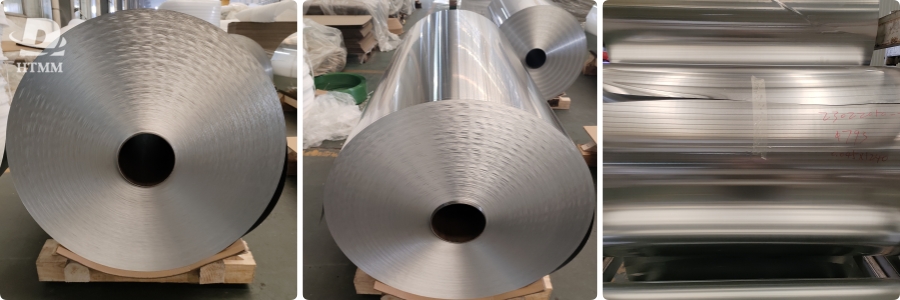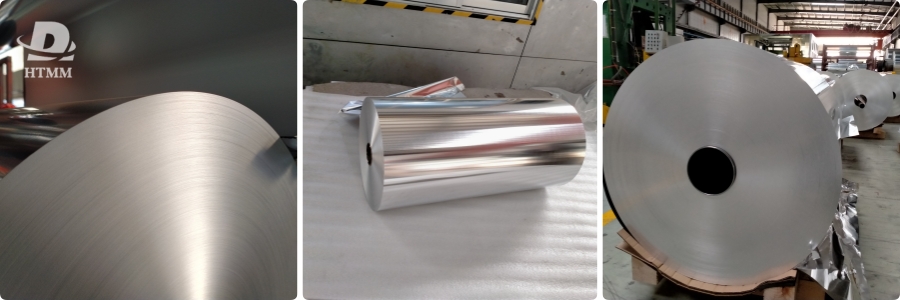
Specifications and Features of 1235 Aluminum Foil
1235 aluminum foil refers to a 1.2%-1.3% manganese alloy system. Its chemical composition complies with ASTM B479 standard.
Some main characteristics of 1235 aluminum foil include:
Smooth and hard surface after cold rolling and annealing, suitable for printing. The average roughness Ra is 0.4-0.6 μm.
High tensile strength of 35-45 N/mm2 and elongation of 3-6%, providing good rigidity.
Good heat resistance up to 150°C for retort sterilization and pasteurization processes.
Superior moisture and grease barrier properties to protect a wide variety of food and consumer goods.
Compliant with food contact regulations in major markets.
Commonly available in gauges of 6-15 μm. Thinner gauges below 8 μm require additional annealing to achieve sufficient ductility.
As the manganese content is higher in 1235 foil than 8079 foil, it delivers better moisture barrier capability which is critical for food packaging. However, its brittleness also limits application in complex packaging formats.
Advantages of 1235 Aluminum Foil
Excellent moisture barrier for dry food and products sensitive to moisture, such as snacks, crackers and biscuits.
Inherently rigid structure provides tight folds and shape retention for premium packaged foods.
High-temperature resistance allows sterilization and retains barrier after retort processing.
Smooth embossable surface enables clear printing and branding.
Specifications and Features of 8079 Aluminum Foil
8079 aluminum foil contains approximately 0.8% manganese. Its characteristics include:
Smooth and soft matte surface with an Ra of 0.3-0.5 μm after rolling and annealing.
Tensile strength of 25-35 N/mm2 and elongation over 35% provide good flexibility and formability.
Heat resistance reaching 120°C accommodates pasteurization applications.
Effective barrier against moisture, grease, oxygen and flavors at normal temperatures.
Available in gauges of 5-15 μm and maintains flexibility even at thinner gauges down to 3 μm.
Compared to 1235 foil, 8079 foil delivers better flexibility, formability and appearance smoothness due to its relatively lower manganese content and softer properties post annealing.
Advantages of 8079 Aluminum Foil
High flexibility and ductility suit complex pouch and bag style packages through form-fill-seal processes.
Conformability to intricate shapes without cracking or pinholes enhances versatile packaging applications.
Trouble-free performance on high-speed packaging lines at desired line speeds.
Aesthetically pleasing matte surface improves printing quality and shelf appeal.
Wrinkle resistance maintains package appearance and strengthens branding impact.
Selection Criteria of 8079 or 1235 Foil for Different Food Packaging

In summary, both 8079 and 1235 are capable aluminum foils for laminated food packaging. Their suitability depends on specific application requirements:
For packaging requiring retort sterilization such as canned foods, 1235 foil is preferred for its greater heat resistance.
Dry snacks and items sensitive to moisture permeation favor 1235 foil due to better grease and moisture barrier.
Pouches and other flexible formats benefit more from 8079 foil thanks to enhanced conformability, fewer wrinkles and beautiful print definition.
Products with complex shapes or packed via form-fill-seal machines are better served by formable and flexible 8079 foil.
Sealant layers and advanced barrier resins can compensate certain barrier shortfalls to some extent and widen the selection.
As a one-stop supplier, HTMM provides high-quality 1235 and 8079 aluminum foils in various tempers and gauges to meet diversified lamination and packaging needs. With reliable supply, advanced production and strict quality management, HTMM aluminum foil efficiently safeguards food quality and safety through packaging solutions.
Lamination Performance Comparison of 1235 and 8079 Foils
Beyond product performance, lamination behavior is another critical factor affecting final package quality and production efficiency.
1235 foil tends to generate more lamination cracks and pinholes compared to 8079 foil during high-speed multi-layer co-extrusion lamination due to its inherent brittleness. This elevates package failure rates.
On the contrary, 8079 foil presents advantages of fewer lamination defects, stable lamination process, higher line speeds as well as consistent lamination quality batch after batch.
In conclusion, 8079 aluminum foil demonstrates more balanced properties between packaging performance and lamination processability. It has become the most widely adopted substrate for flexible pouches addressed to large consumer demographics around the globe. HTMM's premium 8079 foil effectively fulfils all round packaging and lamination requirements for the food and customer goods industries.

